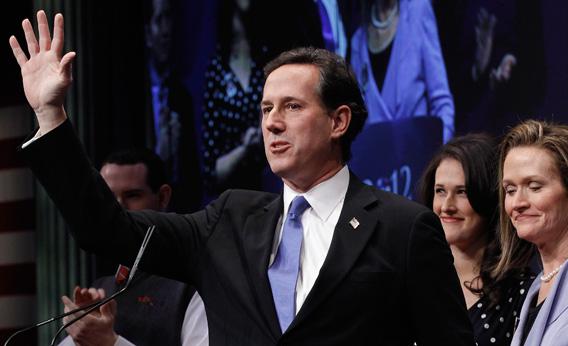After finishing second to Mitt Romney in a straw poll at the Conservative Political Action Conference in Washington, D.C., presidential candidate Rick Santorum insinuated on Sunday that Romney had gamed the vote. “I don’t try to rig straw polls,” Santorum sniped. How, exactly, does a candidate rig a straw poll?
By paying for his supporters to attend. Straw polls, by definition, are nonbinding, so they have fewer rules than do real elections. And unlike opinion polls conducted by national organizations such as Gallup and Pew Research, a straw poll isn’t supposed to be a random sample of the population. Instead, those polled at events such as CPAC and the Ames Straw Poll are simply the people who happen to show up. That means the candidate who turns out the largest number of backers will win. One easy way to get out the straw vote is to buy up a bunch of tickets, then hand them out for free to your supporters. Paying for their transportation to the event can’t hurt. And wining and dining them once they’re there is always a nice touch. Since the CPAC straw poll typically involves about 3,500 people, you might only need to pay for a few hundred voters to tilt the poll in your favor.
Rigging, however, is in the eye of the beholder—usually the loser. “Buying” might be a better word. Straw poll rules vary, but in the case of CPAC and other major events, there’s nothing to prevent a candidate from shelling out cash to gin up support. In fact, that often works to the advantage of the organization running the poll, since it means more people attend the event.
Perhaps the most famous straw poll in American politics is the one held by the Iowa Republican Party in Ames, Iowa, in advance of GOP presidential primaries. That one doubles as a fundraiser for the state party, since anyone who wants to vote must buy a $35 ticket, and the number of tickets is not capped. Campaigns have long recognized that their best chance of winning is to buy up a pile of tickets, give them away to likely backers, and then pay for their transportation to Ames. In 1995, reports that candidates were shuttling people in from other states led organizers to restrict the poll to Iowa residents. Still, spending surged four years later, when Steve Forbes and George W. Bush splashed out $2 million each, chartering luxury buses and hosting musical acts such as Ronnie Milsap and Crystal Gayle. Bush won the poll, and Forbes came in second.
As for CPAC, registration is $75 and up for adults. (It’s cheaper for students—just $35 each—so campaigns might be inclined to target the college crowd.) There are no limits on attendance, so if Romney was trying to stack the vote (as Ron Paul had done in past years), there would have been nothing to stop Santorum from doing the same.
In any case, it’s debatable whether paying supporters to turn out for straw polls is money well-spent, since they have no concrete impact on the election. Rick Perry skipped this year’s Ames vote and vaulted to the top of the polls soon after. Michele Bachmann won and was scarcely heard from again. It’s a violation of federal law to buy votes in a national election with direct cash payments. Still, presidential candidates—especially Democrats—routinely give volunteers “street money” or “walking-around money” to cover expenses during get-out-the-vote efforts.
Bonus Explainer: Why are they called “straw polls?” Because straw is flimsy and shows how the wind is blowing. Sources differ on the phrase’s precise origin, but William Safire’s political dictionary traces it to a 17th-century scholar named John Selden, who said, “Take a straw and throw it up into the air—you may see by that which way the wind is.”
Got a question about today’s news? Ask the Explainer.
Explainer thanks Tim Hagle of the University of Iowa.
